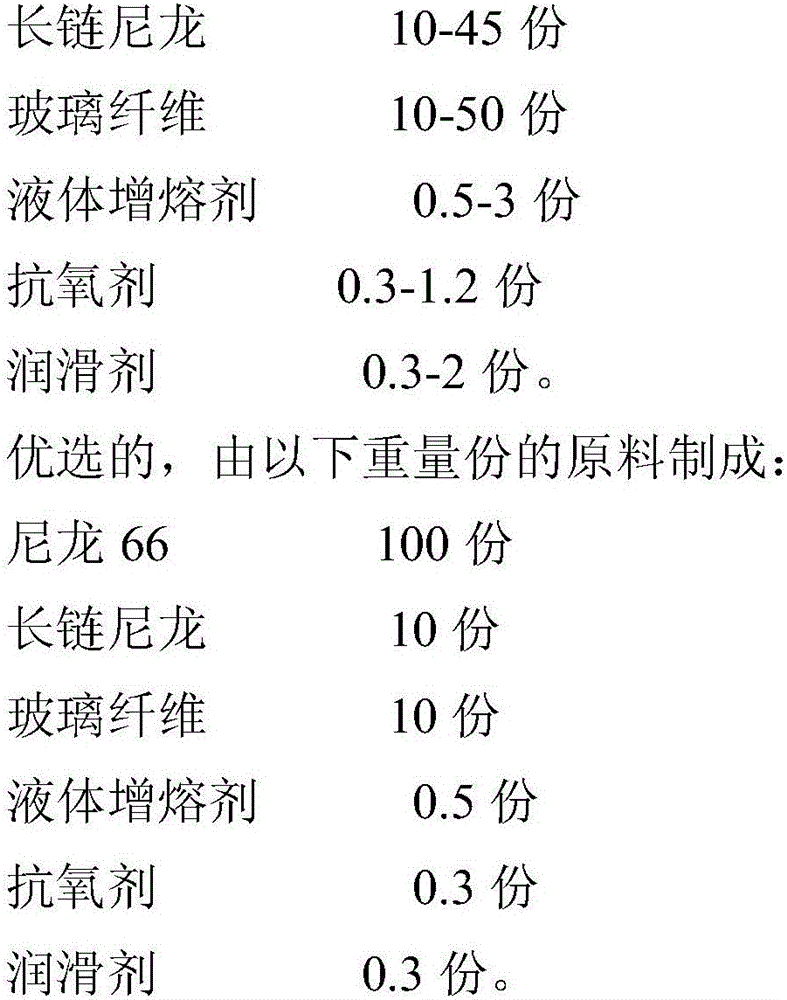Polyamide material with stable melt and anti-chloride solution feature and preparation method thereof
A chloride and polyamide technology, applied in the field of polyamide materials and their preparation, can solve the problems of poor calcium chloride resistance, unstable melt, stable adverse effects on the mechanical properties of materials, etc., and achieves stable production and processing flow, Excellent resistance to chloride salt corrosion, and the effect of improving the strength of the resin solution
- Summary
- Abstract
- Description
- Claims
- Application Information
AI Technical Summary
Problems solved by technology
Method used
Image
Examples
Embodiment 1
[0036] (1) Nylon was dried at 110°C for 2h.
[0037] (2) Weigh 100 parts of PA66 (relative molecular weight 15000-20000), PA61010 parts (relative molecular weight 6000-10000), 0.5 part epoxy-terminated polybutadiene premixed uniformly, and then 0.3 parts of antioxidant and 0.3 part of lubricant Blend into the premix to form a homogeneous mixture;
[0038] (3) Add the mixture from the barrel of the first section of the twin-screw extruder, add 10 parts of glass fiber through the glass fiber port, control the speed at 1100r / min, the temperature at 260-270℃, and carry out extrusion granulation. After extrusion, it is cut into pellets in subcooled water.
[0039] (4) Dry the cut particles and injection molding at 260-275°C. test.
Embodiment 2
[0041] (1) Dry the nylon at 110°C for 2 hours.
[0042] (2) Weigh 100 parts of PA66 (relative molecular weight 15000-30000), PA61045 parts (relative molecular weight 6000-18000), 3 parts epoxy-terminated polybutadiene, and then mix 1.2 parts of antioxidant and 2 parts of lubricant. Blend into the premix to form a homogeneous mixture;
[0043] (3) Add the mixture from the barrel of the first section of the twin-screw extruder, add 50 parts of glass fiber from the first glass fiber port, control the speed of 1100r / min, and the temperature of 260-270°C for extrusion granulation. The material is extruded and cut into pellets in cold water.
[0044] (4) Dry the cut particles and injection molding at 260-275°C. test.
Embodiment 3
[0046] (1) Nylon was dried at 110°C for 2h.
[0047] (2) Weigh 100 parts of PA66 (relative molecular weight 15000-30000), PA61020 parts (relative molecular weight 6000-10000), 1.5 parts epoxy-terminated polybutadiene, and then premix 0.7 parts of antioxidant and 1.4 parts of lubricant Blend into the premix to form a homogeneous mixture;
[0048] (3) Add the mixture from the barrel of the first section of the twin-screw extruder, add 30 parts of glass fiber from the barrel of the fourth section of the twin-screw extruder, control the speed at 1100r / min, and the temperature at 260-270°C for extrusion granulation , The material is extruded and cut into pellets in cold water.
[0049] (4) Dry the cut particles and injection molding at 260-275°C. test.
PUM
| Property | Measurement | Unit |
|---|---|---|
| epoxy value | aaaaa | aaaaa |
| diameter | aaaaa | aaaaa |
Abstract
Description
Claims
Application Information
 Login to View More
Login to View More - Generate Ideas
- Intellectual Property
- Life Sciences
- Materials
- Tech Scout
- Unparalleled Data Quality
- Higher Quality Content
- 60% Fewer Hallucinations
Browse by: Latest US Patents, China's latest patents, Technical Efficacy Thesaurus, Application Domain, Technology Topic, Popular Technical Reports.
© 2025 PatSnap. All rights reserved.Legal|Privacy policy|Modern Slavery Act Transparency Statement|Sitemap|About US| Contact US: help@patsnap.com



